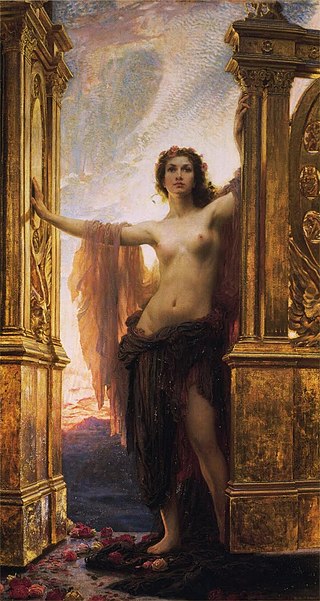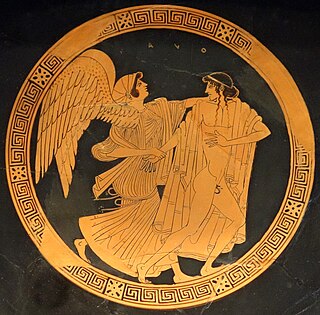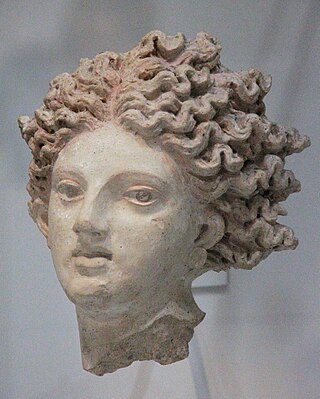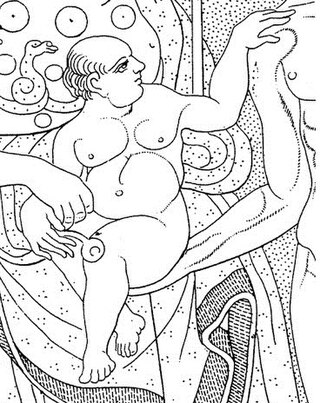
In ancient Greek mythology and religion, Eos is the goddess and personification of the dawn, who rose each morning from her home at the edge of the river Oceanus to deliver light and disperse the night. In Greek tradition and poetry, she is characterized as a goddess with a great sexual appetite, who took numerous human lovers for her own satisfaction and bore them several children. Like her Roman counterpart Aurora and Rigvedic Ushas, Eos continues the name of an earlier Indo-European dawn goddess, Hausos. Eos, or her earlier Proto-Indo-European (PIE) ancestor, also shares several elements with the love goddess Aphrodite, perhaps signifying Eos's influence on her or otherwise a common origin for the two goddesses. In surviving tradition, Aphrodite is the culprit behind Eos' numerous love affairs, having cursed the goddess with insatiable lust for mortal men.

In Greek mythology, Tithonus was the lover of Eos, Goddess of the Dawn. He was a prince of Troy, the son of King Laomedon by the Naiad Strymo (Στρυμώ). The mythology reflected by the fifth-century vase-painters of Athens envisaged Tithonus as a rhapsode, as attested by the lyre in his hand, on an oinochoe of the Achilles Painter, circa 470–460 BC.

Etruscan religion comprises a set of stories, beliefs, and religious practices of the Etruscan civilization, heavily influenced by the mythology of ancient Greece, and sharing similarities with concurrent Roman mythology and religion. As the Etruscan civilization was gradually assimilated into the Roman Republic from the 4th century BC, the Etruscan religion and mythology were partially incorporated into ancient Roman culture, following the Roman tendency to absorb some of the local gods and customs of conquered lands. The first attestations of an Etruscan religion can be traced back to the Villanovan culture.
In Etruscan religion, Fufluns or Puphluns was a god of plant life, happiness, wine, health, and growth in all things. He is mentioned twice among the gods listed in the inscriptions of the Liver of Piacenza, being listed among the 16 gods that rule the Etruscan astrological houses. He is the 9th of those 16 gods. He is the son of Semla and the god Tinia. He was worshipped at Populonia and is the namesake of that town.

In Etruscan mythology and religion, Laran is the god of war. In art, he was portrayed as a naked youth wearing a helmet, a cuirass and carrying a spear, shield, or lance. Laran also appears to be an underworld god. Among his attributes is his responsibility to maintain peace. According to some scholars, he also seems to have been the guardian of boundaries as shown by the boundary cippi found in Bettona with the inscriptions tular Larna and tular larns. Along with eight other Etruscan gods, he can wield lightning. Due to the Tabula Capuana we know that the Laran festival was celebrated on the Ides of May. Laran is the Etruscan equivalent of the Greek Ares and the Roman Mars. Like many other Etruscan gods, his name is gender neutral.

Menrva was an Etruscan goddess of war, art, wisdom, and medicine. She contributed much of her character to the Roman Minerva. She was the child of Uni and Tinia.
In Etruscan religion and myth, Thalna was a divine figure usually regarded as a goddess of childbirth. Determinate gender, however, is not necessarily a characteristic of Etruscan deities, and Thalna is also either depicted as male, or seems to be identified as a male figure because of the placement of names around a scene. Her other functions include friendship and prophecy. Her name may mean "growth, bloom." She appears in Etruscan art in the company of Turan, Tinia, and Menrva.

In Etruscan religion, Hercle, the son of Tinia and Uni, was a version of the Greek Heracles, depicted as a muscular figure often carrying a club and wearing a lionskin. He is a popular subject in Etruscan art, particularly bronze mirrors, which show him engaged in adventures not known from the Greek myths of Heracles or the Roman and later classical myths of Hercules.

Neptune is the god of freshwater and the sea in the Roman religion. He is the counterpart of the Greek god Poseidon. In the Greek-inspired tradition, he is a brother of Jupiter and Pluto, with whom he presides over the realms of heaven, the earthly world, and the seas. Salacia is his wife.

Aurōra is the Latin word for dawn, and the goddess of dawn in Roman mythology and Latin poetry. Like Greek Eos and Rigvedic Ushas, Aurōra continues the name of an earlier Indo-European dawn goddess, Hausos.

Uni is the ancient goddess of marriage, fertility, family, and women in Etruscan religion and myth, and was the patron goddess of Perugia. She is identified as the Etruscan equivalent of Juno in Roman mythology, and Hera in Greek mythology. As the supreme goddess of the Etruscan pantheon, she is part of the Etruscan trinity, an original precursor to the Capitoline Triad, made up of her husband Tinia, the god of the sky, and daughter Menrva, the goddess of wisdom.

Pyrgi was originally an ancient Etruscan town and port in Latium, central Italy, to the north-west of Caere. Its location is now occupied by the borough of Santa Severa. It is notable for the discovery here of the gold tablets, an exceptional epigraphic document with rare texts in Phoenician and Etruscan languages, and also the exceptional terracotta pediment statues from the temple.

Usil is the Etruscan god of the sun, shown to be identified with Apulu (Apollo). His iconic depiction features Usil rising out of the sea, with a fireball in either outstretched hand, on an engraved Etruscan bronze mirror in late Archaic style, formerly on the Roman antiquities market. On Etruscan mirrors in the Classical style, Usil appears with an aureole.
Cel was the Etruscan goddess of the earth. On the Etruscan calendar, the month of Celi (September) is likely named for her. Her Greek counterpart is Gaia and her Roman is Tellus.

Catha is a female Etruscan lunar or solar deity, who may also be connected to childbirth, and has a connection to the underworld. Catha is also the goddess of the south sanctuary at Pyrgi, Italy.

Ethausva is an Etruscan divine figure that appears in a few Etruscan inscriptions. She is depicted as a winged female richly robed and wearing a jeweled crown on her head. Her lack of mention on Etruscan artwork and inscriptions suggest that she was not very common, but she was considered canon to the Etruscan Pantheon so she was still known during the time of the Etruscans.

Epiur is an Etruscan mythological figure that appears on bronze Etruscan engraved mirrors. He is shown as an infant that has the face of a young man. He is also often winged and being held by Hercle or Menrva, who are charged with the protection and care of infants. He is also often shown to be presented to other gods.

In Greek mythology, Cephalus is a Aeolian prince, the son of Deion/Deioneos, ruler of Phocis, and Diomede, and grandson of Aeolus. He was one of the lovers of the dawn goddess Eos.

Apulu, also syncopated as Aplu, is an epithet of the Etruscan fire god Śuri as chthonic sky god, roughly equivalent to the Greco-Roman god Apollo. Their names are associated on Pyrgi inscriptions too. The name Apulu or Aplu did not come directly from Greece but via a Latin center, probably Palestrina.
Śuri, Latinized as Soranus, was an ancient Etruscan infernal, volcanic and solar fire god, also venerated by other Italic peoples – among them Capenates, Faliscans, Latins and Sabines – and later adopted into ancient Roman religion.


















